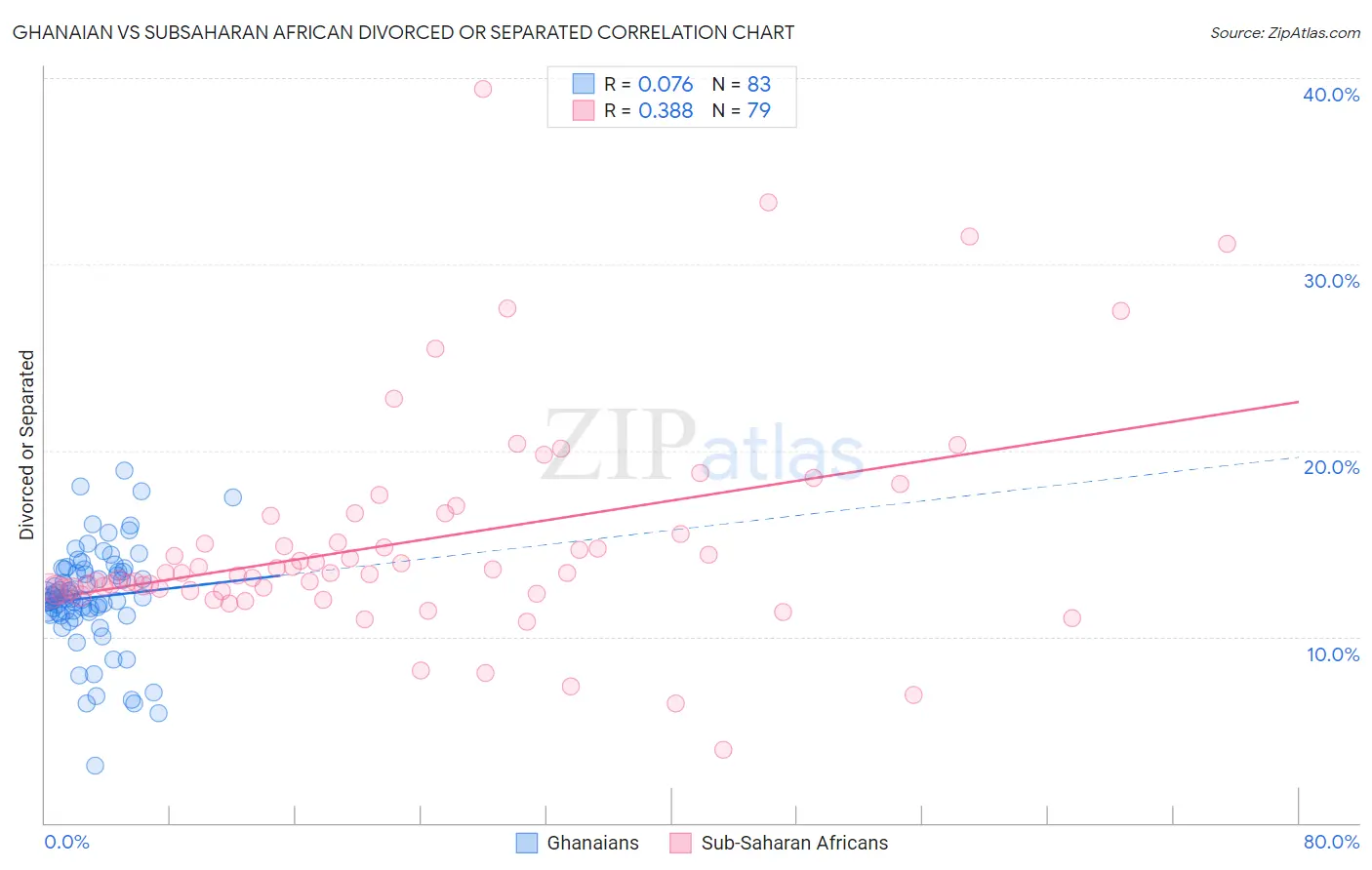Ghanaian vs Subsaharan African Divorced or Separated
COMPARE
Ghanaian
Subsaharan African
Divorced or Separated
Divorced or Separated Comparison
Ghanaians
Sub-Saharan Africans
12.1%
DIVORCED OR SEPARATED
45.9/ 100
METRIC RATING
178th/ 347
METRIC RANK
12.7%
DIVORCED OR SEPARATED
0.1/ 100
METRIC RATING
282nd/ 347
METRIC RANK
Ghanaian vs Subsaharan African Divorced or Separated Correlation Chart
The statistical analysis conducted on geographies consisting of 190,579,884 people shows a slight positive correlation between the proportion of Ghanaians and percentage of population currently divorced or separated in the United States with a correlation coefficient (R) of 0.076 and weighted average of 12.1%. Similarly, the statistical analysis conducted on geographies consisting of 507,827,607 people shows a mild positive correlation between the proportion of Sub-Saharan Africans and percentage of population currently divorced or separated in the United States with a correlation coefficient (R) of 0.388 and weighted average of 12.7%, a difference of 5.5%.

Divorced or Separated Correlation Summary
| Measurement | Ghanaian | Subsaharan African |
| Minimum | 3.1% | 3.9% |
| Maximum | 18.9% | 39.4% |
| Range | 15.8% | 35.5% |
| Mean | 12.1% | 15.1% |
| Median | 12.1% | 13.4% |
| Interquartile 25% (IQ1) | 11.3% | 12.5% |
| Interquartile 75% (IQ3) | 13.6% | 16.5% |
| Interquartile Range (IQR) | 2.3% | 4.0% |
| Standard Deviation (Sample) | 2.7% | 6.0% |
| Standard Deviation (Population) | 2.7% | 5.9% |
Similar Demographics by Divorced or Separated
Demographics Similar to Ghanaians by Divorced or Separated
In terms of divorced or separated, the demographic groups most similar to Ghanaians are Immigrants from Western Europe (12.1%, a difference of 0.010%), Barbadian (12.1%, a difference of 0.030%), Brazilian (12.1%, a difference of 0.060%), Immigrants from Canada (12.1%, a difference of 0.060%), and Immigrants from Ethiopia (12.1%, a difference of 0.10%).
| Demographics | Rating | Rank | Divorced or Separated |
| Costa Ricans | 53.3 /100 | #171 | Average 12.0% |
| Immigrants | Mexico | 53.2 /100 | #172 | Average 12.0% |
| Immigrants | Moldova | 50.4 /100 | #173 | Average 12.1% |
| Hawaiians | 50.0 /100 | #174 | Average 12.1% |
| Immigrants | Sierra Leone | 50.0 /100 | #175 | Average 12.1% |
| Pennsylvania Germans | 48.9 /100 | #176 | Average 12.1% |
| Brazilians | 47.7 /100 | #177 | Average 12.1% |
| Ghanaians | 45.9 /100 | #178 | Average 12.1% |
| Immigrants | Western Europe | 45.6 /100 | #179 | Average 12.1% |
| Barbadians | 45.0 /100 | #180 | Average 12.1% |
| Immigrants | Canada | 44.0 /100 | #181 | Average 12.1% |
| Immigrants | Ethiopia | 43.1 /100 | #182 | Average 12.1% |
| Immigrants | Central America | 42.9 /100 | #183 | Average 12.1% |
| Immigrants | North America | 41.1 /100 | #184 | Average 12.1% |
| Immigrants | Nigeria | 40.5 /100 | #185 | Average 12.1% |
Demographics Similar to Sub-Saharan Africans by Divorced or Separated
In terms of divorced or separated, the demographic groups most similar to Sub-Saharan Africans are Delaware (12.7%, a difference of 0.010%), Nonimmigrants (12.8%, a difference of 0.10%), Pueblo (12.7%, a difference of 0.12%), French (12.8%, a difference of 0.14%), and Immigrants from Zaire (12.7%, a difference of 0.16%).
| Demographics | Rating | Rank | Divorced or Separated |
| Central American Indians | 0.3 /100 | #275 | Tragic 12.7% |
| Spaniards | 0.2 /100 | #276 | Tragic 12.7% |
| Dominicans | 0.2 /100 | #277 | Tragic 12.7% |
| Lumbee | 0.2 /100 | #278 | Tragic 12.7% |
| Immigrants | Dominican Republic | 0.2 /100 | #279 | Tragic 12.7% |
| Immigrants | Zaire | 0.2 /100 | #280 | Tragic 12.7% |
| Pueblo | 0.2 /100 | #281 | Tragic 12.7% |
| Sub-Saharan Africans | 0.1 /100 | #282 | Tragic 12.7% |
| Delaware | 0.1 /100 | #283 | Tragic 12.7% |
| Immigrants | Nonimmigrants | 0.1 /100 | #284 | Tragic 12.8% |
| French | 0.1 /100 | #285 | Tragic 12.8% |
| Spanish | 0.1 /100 | #286 | Tragic 12.8% |
| Hondurans | 0.1 /100 | #287 | Tragic 12.8% |
| French Canadians | 0.1 /100 | #288 | Tragic 12.8% |
| Iroquois | 0.0 /100 | #289 | Tragic 12.9% |